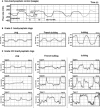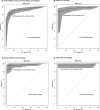Whole-Body Barometric Plethysmography Characterizes Upper Airway Obstruction in 3 Brachycephalic Breeds of Dogs
- PMID: 27159898
- PMCID: PMC4913582
- DOI: 10.1111/jvim.13933
Whole-Body Barometric Plethysmography Characterizes Upper Airway Obstruction in 3 Brachycephalic Breeds of Dogs
Abstract
Background: A novel test using whole-body barometric plethysmography (WBBP) was developed recently to diagnose brachycephalic obstructive airway syndrome (BOAS) in unsedated French bulldogs.
Hypothesis/objectives: The hypotheses of this study were: (1) respiratory characteristics are different between healthy nonbrachycephalic dogs and brachycephalic dogs; and among pugs, French bulldogs, and bulldogs; and (2) obesity and stenotic nares are risk factors for BOAS. The main objective was to establish a diagnostic test for BOAS in these 3 breeds.
Animals: A total of 266 brachycephalic dogs (100 pugs, 100 French bulldogs, and 66 bulldogs) and 28 nonbrachycephalic dogs.
Methods: Prospective study. Exercise tolerance tests with respiratory functional grading, and WBBP were performed on all dogs. Data from WBBP were associated with functional grades to train quadratic discriminant analysis tools to assign dogs to BOAS+ and BOAS- groups. A BOAS index (0-100%) was calculated for each dog. Receiver operating characteristic (ROC) curves were used to evaluate classification ability.
Results: Minute volume was decreased significantly in asymptomatic pugs (P = .009), French bulldogs (P = .026), and bulldogs (P < .0001) when compared to nonbrachycephalic controls. Respiratory characteristics were different among breeds and affected dogs had a significant increase in trace variation. The BOAS index predicted BOAS status for each breed with 94-97% (95% confidence interval [CI], 88.9-100%) accuracy (area under the ROC curve). Both obesity (P = .04) and stenotic nares (P = .004) were significantly associated with BOAS.
Conclusions and clinical importance: The WBBP can be used as a clinical tool to diagnose BOAS noninvasively and objectively.
Keywords: Brachycephalic obstructive airway syndrome; Quadratic discriminant analysis; Respiratory function test; Whole-body barometric plethysmography.
Copyright © 2016 The Authors. Journal of Veterinary Internal Medicine published by Wiley Periodicals, Inc. on behalf of the American College of Veterinary Internal Medicine.
Figures




Similar articles
-
Characterisation of Brachycephalic Obstructive Airway Syndrome in French Bulldogs Using Whole-Body Barometric Plethysmography.PLoS One. 2015 Jun 16;10(6):e0130741. doi: 10.1371/journal.pone.0130741. eCollection 2015. PLoS One. 2015. PMID: 26079684 Free PMC article.
-
Conformational risk factors of brachycephalic obstructive airway syndrome (BOAS) in pugs, French bulldogs, and bulldogs.PLoS One. 2017 Aug 1;12(8):e0181928. doi: 10.1371/journal.pone.0181928. eCollection 2017. PLoS One. 2017. PMID: 28763490 Free PMC article.
-
Validation of exercise testing and laryngeal auscultation for grading brachycephalic obstructive airway syndrome in pugs, French bulldogs, and English bulldogs by using whole-body barometric plethysmography.Vet Surg. 2019 May;48(4):488-496. doi: 10.1111/vsu.13159. Epub 2019 Jan 21. Vet Surg. 2019. PMID: 30666670
-
Updates in Upper Respiratory Surgery.Vet Clin North Am Small Anim Pract. 2022 Mar;52(2):339-368. doi: 10.1016/j.cvsm.2021.12.002. Epub 2022 Jan 24. Vet Clin North Am Small Anim Pract. 2022. PMID: 35082092 Review.
-
Surgical management of brachycephalic obstructive airway syndrome: An update on options and outcomes.Vet Surg. 2024 Oct;53(7):1173-1184. doi: 10.1111/vsu.14131. Epub 2024 Jul 1. Vet Surg. 2024. PMID: 38952039 Review.
Cited by
-
Health of Pug dogs in the UK: disorder predispositions and protections.Canine Med Genet. 2022 May 18;9(1):4. doi: 10.1186/s40575-022-00117-6. Canine Med Genet. 2022. PMID: 35581668 Free PMC article.
-
Effect of transoral tracheal wash on respiratory mechanics in dogs with respiratory disease.Can J Vet Res. 2018 Jan;82(1):75-79. Can J Vet Res. 2018. PMID: 29382973 Free PMC article.
-
Evaluation of the Submaximal Treadmill-Based Fitness Test in Six Brachycephalic Breeds-A Follow-Up Study.Animals (Basel). 2023 Nov 3;13(21):3413. doi: 10.3390/ani13213413. Animals (Basel). 2023. PMID: 37958168 Free PMC article.
-
Reference ranges for standard-echocardiography in pugs and impact of clinical severity of Brachycephalic Obstructive Airway Syndrome (BOAS) on echocardiographic parameters.BMC Vet Res. 2022 Jul 20;18(1):282. doi: 10.1186/s12917-022-03348-8. BMC Vet Res. 2022. PMID: 35854376 Free PMC article.
-
Fluoroscopic Estimation of Thoracic Dimensional Changes in Healthy Dogs.J Vet Intern Med. 2017 Nov;31(6):1841-1848. doi: 10.1111/jvim.14825. Epub 2017 Sep 29. J Vet Intern Med. 2017. PMID: 28961336 Free PMC article.
References
-
- Oechtering G. Brachycephalic syndrome – new information on an old congenital disease. Vet Rec 2010;20:2–9.
-
- Hendricks J. Brachycephalic airway syndrome In: King L, ed. Textbook of Respiratory Disease in Dogs and Cats. St Louis: Saunders; 2004:310–318.
-
- Amis TC, Kurpershoek C. Tidal breathing flow‐volume loop analysis for clinical assessment of airway obstruction in conscious dogs. Am J Vet Res 1986;47:1002–1006. - PubMed
-
- Amis TC, Kurpershoek C. Pattern of breathing in brachycephalic dogs. Am J Vet Res 1986;47:2200–2204. - PubMed
Publication types
MeSH terms
LinkOut - more resources
Full Text Sources
Other Literature Sources
Medical

